
Private equity (PE) is leaving billions of dollars in sustainability value on the table. While some practitioners focus on the value proposition of sustainability, the current status leaves much to be desired. Gaps in current approaches include cumbersome frameworks focused on risk compliance rather than value creation, difficulty capturing the financial benefits of a sustainability strategy, lack of clarity around which KPIs to track, and significant communication issues between general partners (GPs) and limited partners (LPs). This Viewpoint introduces a powerful tool to better identify value creation and risk-mitigating opportunities at the due diligence and early holding phases.
Between 2010 and 2022, assets under management of PE more than quadrupled. As the PE industry continues to expand, there is a growing opportunity to generate financial and societal value through sustainability initiatives. Increasing the availability of finance is also a key lever to move the industry toward net zero goals; for example, according to BloombergNEF, only about 16% of climate finance needs are currently being met. Because PE firms often hold majority control over their portfolio companies, they wield considerable power to implement sustainability initiatives across a wide swath of industries at the portfolio company level.
However, many PE firms are currently poorly identifying and capturing sustainability value. Based on new research by the New York University Stern Center for Sustainable Business (NYU Stern CSB) in collaboration with Arthur D. Little (ADL), we know that most GPs tend to focus on identifying red flags during due diligence (with a few leading exceptions, especially in Europe) but rarely look into sustainability value creation. After purchase, GPs may track a few environmental, social, and governance (ESG) reporting metrics but often do not implement sustainability value creation plans.
This Viewpoint outlines a new tool (open source and available free of charge) developed jointly by NYU Stern CSB and ADL to help GPs better identify and capture sustainability value, both at the due diligence phase and during the first few months of the holding period.
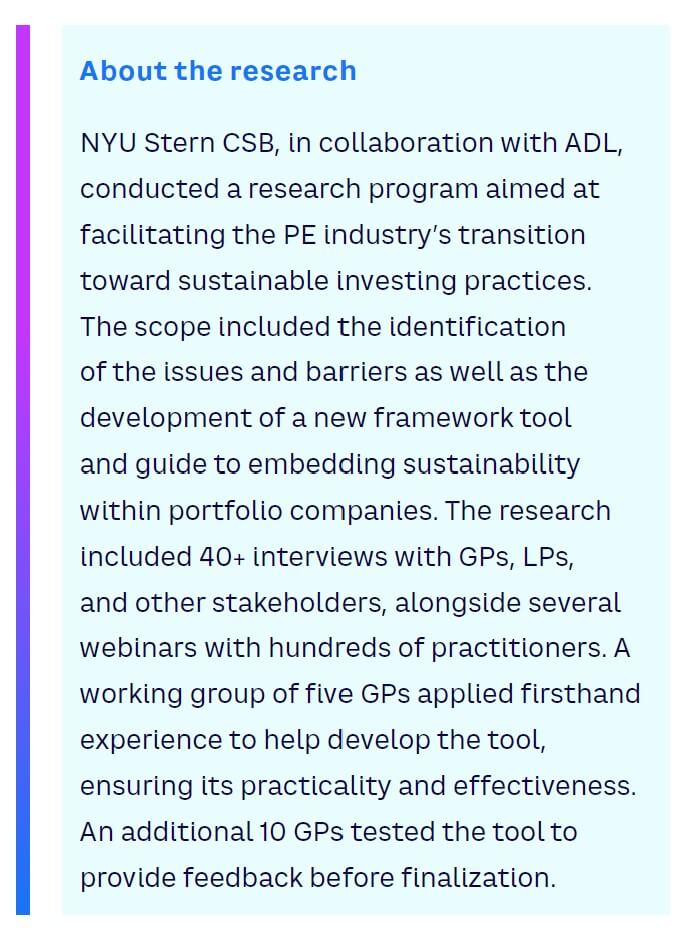
OPPORTUNITIES FOR IMPROVEMENT
The research identified several clear opportunities for improvement in how GPs approach sustainability during the investment lifecycle. Underlying these opportunities is the basic premise that GPs still tend to approach sustainability as primarily a reporting issue rather than a potential driver of value during each stage:
-
Deal-sourcing/pre-due diligence phase. Current practice focuses on ESG data requests, checking against general exclusions, and often applying a gating methodology based on specific criteria (e.g., an impact investor might use criteria focused on quality jobs). This type of approach may be adequate for the pre-phase, although knowing how much depth to aim for can still be difficult.
-
Due diligence phase. This typically involves reviewing material issues, including ESG KPIs if available and an ESG scorecard. ESG sensitivities may be applied to valuation analyses to reflect possible impacts. The main shortcomings are an emphasis on red flag downside risks, superficiality in understanding the full extent of ESG issues, lack of data (especially for small and medium-sized enterprises), and limited or no focus on upside opportunities from sustainability (e.g., the financial upside of mitigating risks that may drive improved performance or how sustainability investments could build competitive advantage).
-
Early investment and holding phase. Current common practice includes conducting a basic ESG materiality assessment, tracking some ESG KPIs, putting in place ESG accountability structures, and creating annual sustainability reports. However, there is often a lack of understanding of which ESG KPIs and sustainability levers to focus on. There can be an emphasis on process, rather than outcome and metrics, without enough attention given to return on sustainability investment (ROSI) and value creation. GPs may conduct a basic ESG materiality assessment and track a few reporting metrics but often do not progress these further. ESG reporting metrics typically focus on the output or existence of a policy rather than the outcome or underlying performance (e.g., “check-the-box” reporting).
-
Exit. At the exit stage, the lack of effective ESG metrics and data means that value growth and ROSI achieved are hard to demonstrate. Research indicates that there is some uplift in the valuations of companies that implement strong sustainability practices, so investors might be missing out on higher valuations. GPs reported that investors are asking for sustainability narratives at exit, but GPs currently lack the underlying data to validate these narratives.
So there are significant opportunities for improvement in terms of better identifying sustainability benefits as well as risks, understanding and prioritizing material issues, and adopting more performance-based KPIs.
This enables better monetization of sustainability benefits and the development of a stronger sustainability narrative over time, grounded in real data. Striking a balance between short-term efficiency gains and sustained revenue growth is crucial. GPs must ensure the long-term viability of assets rather than short-term value extraction. Targeted sustainability strategies can unlock value, drive top-line growth, and proactively address material issues to prevent future value erosion. Both the due diligence and early holding phases are important for realizing these opportunities.
NEW TOOL TO HELP UNLOCK SUSTAINABILITY VALUE
In our research, many GPs confirmed that sustainability practices can derive more value, provided they have the right tools. NYU Stern CSB, with ADL support, has developed a practical tool to address these needs across the due diligence and early holding periods (see Figure 1):
-
Phase 1 — due diligence. The tool helps conduct a high-level assessment of ESG-related risks and opportunities, offering insights into potential financial improvements as well as red flags.
-
Phase 2 — early holding period. Tailored for the first 100 days of managing a newly acquired portfolio company, the tool enables GPs to analyze and prioritize material issues and strategies and develop specific, performance-based KPIs through a more extensive analysis.

How the tool works: Phase 1 due diligence
Figure 2 summarizes the modus operandi of the tool for the due diligence phase. The purpose of the tool for this phase is to help the user focus on those sustainability issues and strategies that are of greatest importance and relevance for the company being assessed. Once the user inputs the sector, the tool automatically identifies:
-
The most relevant material issues for the sector, as defined by the Sustainability Accounting Standards Board (SASB)
-
Good practice strategies, practices, and value drivers (defined by NYU Stern CSB)
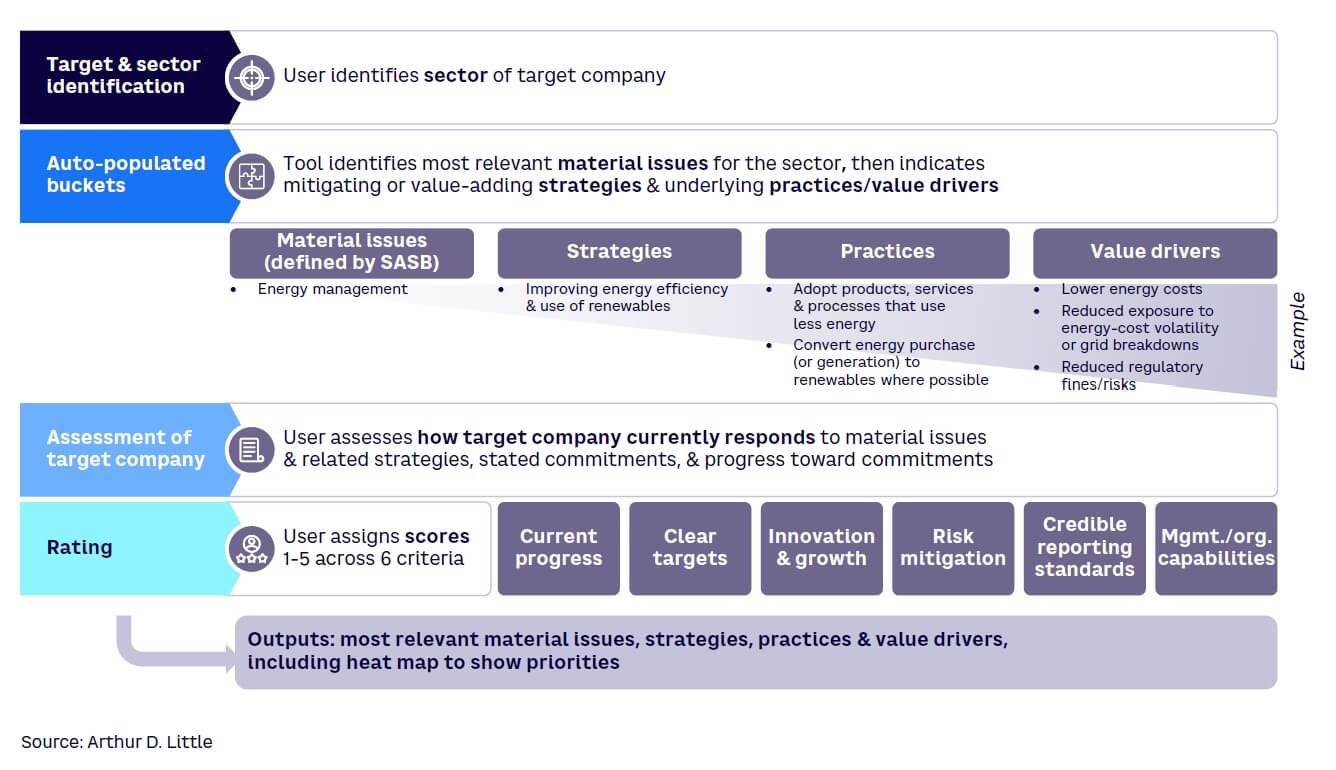
With this as guidance, the user briefly researches each material issue, specifically looking at stated commitments and progress toward these commitments. Finally, the user assesses the target’s performance on each material issue across six criteria by assigning a score of one to five for each. The criteria comprise current progress versus commitments and targets, innovation and growth, risk mitigation, reporting standards, and management capabilities. The tool provides word models to help the user decide which score to assign and recommended weightings for each criterion that the user can modify, if needed.
By way of output, the tool provides a summary heat map that clearly shows areas with the highest risks, as well as those with the potential for value enhancement (see Figure 3). Initial feedback from GPs indicated an appreciation for the efficiency of the tool, especially given the tight time constraints during the due diligence period.
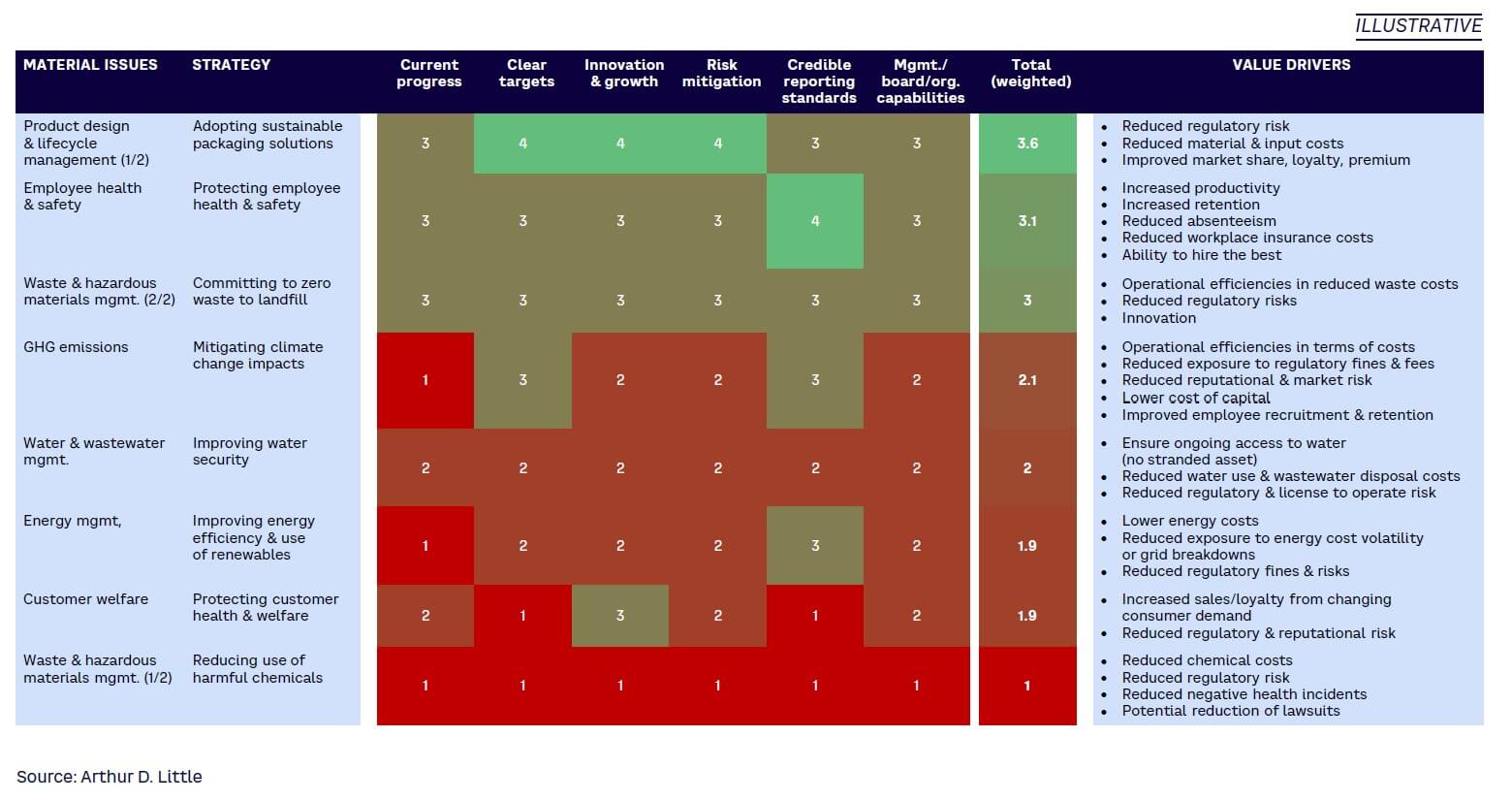
How the tool works: Phase 2 early holding period
Figure 4 summarizes the modus operandi of the tool for the early holding period phase. The purpose of the tool for the early holding period (e.g., the first 100 days) is to help the GP identify and further explore top-priority issues based on downside risk and upside value potential, develop the most effective KPIs and strategies, and easily create a full record of sustainability progress. Conducting this analysis promptly at the start of the holding period allows the GP to begin tracking ESG and ROSI KPIs from the beginning, allowing the creation of a record of sustainability improvement over the lifetime of the holding. Thus, at exit, the GP can more easily demonstrate a sustainable growth story.
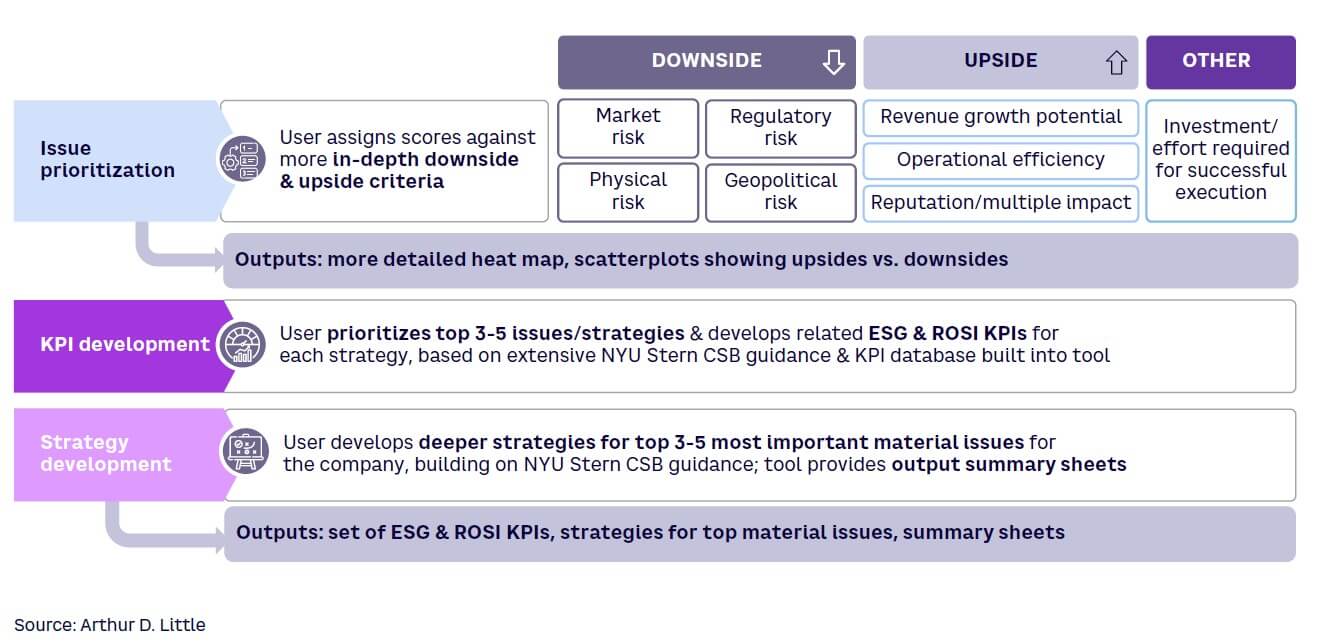
This phase of the assessment begins with the user conducting a more in-depth issue prioritization (the tool provides the user with further guidance on best-practice and scoring criteria). The tool uses this prioritization to generate a second, more detailed, heat map (not shown here) versus the downside/upside/other criteria as shown in Figure 4. Along with the heat map, the tool generates other outputs, including scatterplots (see Figure 5).
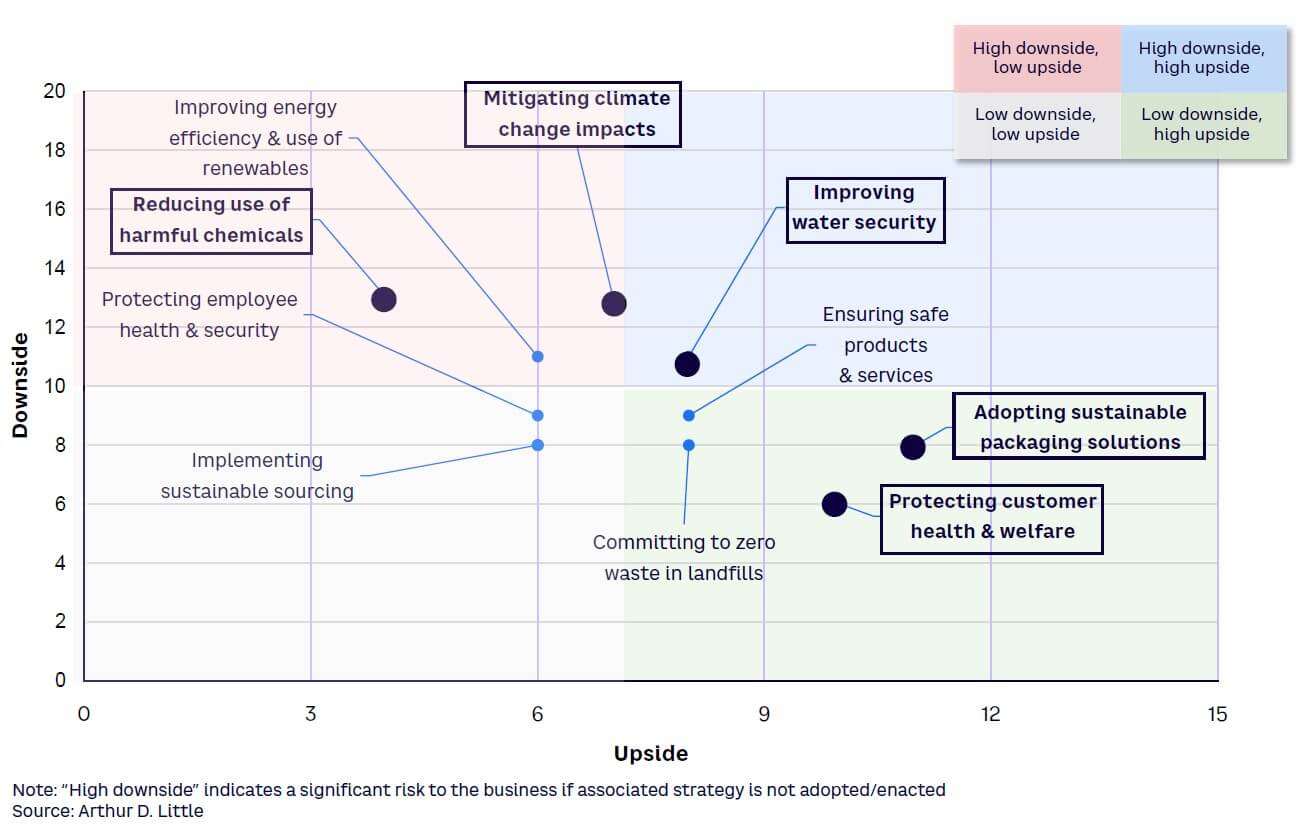
The scatterplot is useful for ensuring that upside opportunities are not neglected in prioritization. For example, in the case shown above for a food and beverage company, “improving water security’ appears in the top-right quadrant because along with the downside risk of poor water stewardship, there are significant upsides from reducing water consumption and wastewater generation. In this case, the company realized a 10% water-usage reduction in a few years, aiming for 15% by 2025. The tool also provides a variety of scatterplots to get a better sense of how the material issues compare and contrast from an upside and downside perspective.
The next step for the GP user is to develop KPIs that track ROSI. The tool provides an extensive database of KPIs that the user can use off the shelf or as a guide to develop more targeted KPIs for their specific business. The database includes, for each material issue, recommended KPIs and ROSI descriptions, monetization examples, and typical good practices. The GP can then begin tracking these specific, performance-based KPIs throughout the lifetime of their investment. In this way, the tool encourages the collection of real sustainability data rather than the typical check-the-box exercise that often appears in ESG reporting.
Finally, the tool outputs two summary sheets, one of which highlights the most important findings to be shared in any investment committee meetings, as well as an overarching sheet that compiles all the analysis generated throughout the process for the top-identified material issues and strategies.
The due diligence analysis phase takes a few hours to complete; the early holding period analysis requires a longer effort (likely a few days). The model is bifurcated to provide value during each phase, especially given the tight time/resource constraints during the due diligence period.
Conclusion
CAPTURE FINANCIAL VALUE WITH IMPACTFUL SUSTAINABILITY STRATEGIES
As PE practitioners increasingly include sustainability priorities in their investments, there is a significant opportunity to increase financial returns while also enhancing environmental and societal impact. Many private market investors currently focus on ESG and sustainability as a compliance exercise, leaving value-creation opportunities untapped. However, this trend is shifting as investors now see the value of integrating a more meaningful sustainability strategy. Our value creation tool allows GPs to more easily:
-
Identify key material issues and associated risk-mitigating and value-creating strategies, practices, and value drivers.
-
Provide a high-level assessment of ESG-related risks and opportunities during due diligence that can drive improved financial performance.
-
Prioritize the most important material issues and related strategies to best focus time and efforts on the implementation of a short list of strategies that drive real impact.
-
Create KPIs that capture the underlying financial value of these strategies, leading to a sustainable growth story at exit.






